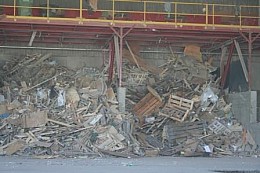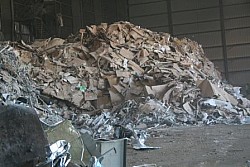April 28, 2015
The Delaware Recycling Center (DRC) in New Castle presents a model for today’s recycling. The Delaware Solid Waste Authority has a goal of creating a “green campus” at the DRC. DSWA has partnered with ReCommunity to run a single-stream materials recovery facility. Last week’s blog featured pictures of a tour of the ReCommunity facility offered during NERC’s recent conference in Delaware.
Also on-site at the DRC is DSWA’s Environmental Education Building. The education building includes a classroom with multimedia equipment where DSWA’s education staff presents information on DSWA facilities and programs. Used electronics and household hazardous waste are collected each Wednesday at the DRC facility. There is also a single stream recycling drop-off center that is available during business hours, along with a special container for polystyrene (Styrofoam™) recycling.
Revolution Recovery is another recycling partner at the DRC. The Philadelphia-based company provides dumpsters to construction sites, manufacturers, businesses, industry and residences; processes both mixed and separated construction and demolition (C&D) materials such as wood, drywall, metal, and carpet. Having never visited a construction and demolition processing facility it was very interesting. It’s pretty much like single-stream recycling—most of the C&D comes in mixed and through mechanical and human sorting marketable commodities result.
Incoming material is dumped on a tipping floor and inspected. There is of course the usual fork lifts and loaders used to begin the separation, removing large items—metals for example. The 84,000 square feet facility has a 300-foot mechanical separation system. Conveyer belts carry mixed loads of C&D up a sorting conveyer and picking line where workers separate out materials by hand. Interestingly, when we toured, materials had been moved around to make room for a new addition, so workers were sorting through a huge mound of cardboard on the ground. Definitely a dusty, arduous job!
 Wood waste—crates, pallets, lumber, studs, concrete formwork and beams—is recovered from mixed debris and further graded (by workers) into clean (unpainted and untreated) wood and engineered woods. The company uses a grinder to chip the wood. Material is screened and passed by a magnet that removes any remaining nails and other steel. Clean wood chips are made into mulch products; engineered woodchips go through additional processing and are made into fuel products.
Wood waste—crates, pallets, lumber, studs, concrete formwork and beams—is recovered from mixed debris and further graded (by workers) into clean (unpainted and untreated) wood and engineered woods. The company uses a grinder to chip the wood. Material is screened and passed by a magnet that removes any remaining nails and other steel. Clean wood chips are made into mulch products; engineered woodchips go through additional processing and are made into fuel products.
 Drywall is shredded and the paper is screened from the gypsum. The gypsum is then screened again leaving a “clast” (pebble) sized product and a powder. Both of these are primarily used by agricultural markets, either spread on farm fields or mixed in soil for growing mushrooms. The paper is used as animal bedding. Plastics found in construction and industrial debris include HDPE buckets, storm pipe, crates, shrink wrap, poly sheeting and more. Looking at the sea of material in the Revolution Recovery incoming stream, there were a lot of buckets and shrink wrap. Workers sort plastics by type; the sorted material is then baled. Interestingly, the company accepts plastic car bumpers from a local auto shop. Carpet is also collected and marketed when possible.
Drywall is shredded and the paper is screened from the gypsum. The gypsum is then screened again leaving a “clast” (pebble) sized product and a powder. Both of these are primarily used by agricultural markets, either spread on farm fields or mixed in soil for growing mushrooms. The paper is used as animal bedding. Plastics found in construction and industrial debris include HDPE buckets, storm pipe, crates, shrink wrap, poly sheeting and more. Looking at the sea of material in the Revolution Recovery incoming stream, there were a lot of buckets and shrink wrap. Workers sort plastics by type; the sorted material is then baled. Interestingly, the company accepts plastic car bumpers from a local auto shop. Carpet is also collected and marketed when possible.
Ferrous metal is removed from the mixed C&D and marketed for use in the steel industry. Nonferrous metal is further sorted for its valuable components, including copper. Once removed from the mixed C&D, cardboard and mixed paper are baled for paper markets.
Rubble, including brick, block, concrete, masonry, stone, and asphalt, is separated and run through a concrete crusher that hammers the material until it is fine enough to pass through screens that further separate the material by a range of sizes. Magnets remove any metal (like rebar). The different sized products are used in a variety of applications. Large pieces are used in drainage ditches, or temporary roads, as they allow water to pass through and prevent puddles and mud pits. Finer pieces are used for many applications, from road base to backfilling.
The company reports that about 80% of its inbound material is recycled. It has an interesting combination of technology and plenty of hands-on labor to accomplish this. It’s hard to figure out how mounds of mixed C&D and the number of staff required to run the facility can turn a profit, but Revolution Recovery has been in business for a few years now. I guess it’s working!
By Athena Lee Bradley



Comments (0)
Add a Comment